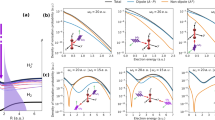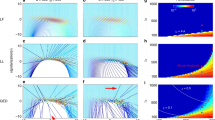Abstract
Classical Thomson scattering1 — the scattering of low-intensity light by electrons — is a linear process, in that it does not change the frequency of the radiation; moreover, the magnetic-field component of light is not involved. But if the light intensity is extremely high (∼1018 W cm−2), the electrons oscillate during the scattering process with velocities approaching the speed of light. In this relativistic regime, the effect of the magnetic and electric fields on the electron motion should become comparable, and the effective electron mass will increase. Consequently, electrons in such high fields are predicted to quiver nonlinearly, moving in figure-of-eight patterns rather than in straight lines. Scattered photons should therefore be radiated at harmonics of the frequency of the incident light2,3,4,5,6,7,8, with each harmonic having its own unique angular distribution4,5,6. Ultrahigh-peak-power lasers9 offer a means of creating the huge photon densities required to study relativistic, or ‘nonlinear’ (ref. 6), Thomson scattering. Here we use such an approach to obtain direct experimental confirmation of the theoretical predictions of relativistic Thomson scattering. In the future, it may be possible to achieve coherent10,11 generation of the harmonics, a process that could be potentially utilized for ‘table-top’ X-ray sources.
This is a preview of subscription content, access via your institution
Access options
Subscribe to this journal
Receive 51 print issues and online access
$199.00 per year
only $3.90 per issue
Buy this article
- Purchase on Springer Link
- Instant access to full article PDF
Prices may be subject to local taxes which are calculated during checkout




Similar content being viewed by others
References
Thomson, J. J. Conduction of Electricity through Gases (Cambridge Univ. Press, 1906).
Vachaspati Harmonics in the scattering of light by free electrons. Phys. Rev. 128, 664–666 (1962).
Brown, L. S. & Kibble, T. W. B. Interaction of intense laser beams with electrons. Phys. Rev. 133, A705–A719 (1964).
Sarachik, E. S. & Schappert, G. T. Classical theory of the scattering of intense laser radiation by free electrons. Phys. Rev. D 1, 2738–2753 (1970).
Castillo-Herrera, C. I. & Johnston, T. W. Incoherent harmonic emission from strong electromagnetic waves in plasmas. IEEE Trans. Plasma Sci. 21, 125–135 (1993).
Esarey, E., Ride, S. K. & Sprangle, P. Nonlinear Thomson scattering of intense laser pulses from beams and plasmas. Phys. Rev. E 48, 3003–3021 (1993).
Hartemann, F. V. & Luhmann, N. C. J Classical electrodynamical derivation of the radiation damping force. Phys. Rev. Lett. 74, 1107–1110 (1995).
Hartemann, F. V. High-intensity scattering processes of relativistic electrons in vacuum. Phys. Plasmas 5, 2037–2047 (1998).
Maine, P. et al. Generation of ultrahigh peak power pulses by chirped pulse amplification. IEEE J. Quantum Electron. 24, 398–403 (1988).
Esarey, E. et al. Nonlinear analysis of relativistic harmonic generation by intense lasers in plasmas. IEEE Trans. Plasma Sci. 21, 95–104 (1993).
Esarey, E. & Sprangle, P. Generation of stimulated backscattered harmonic generation from intense-laser interactions with beams and plasmas. Phys. Rev. A 45, 5872–5882 (1992).
Meyer, J. & Zhu, Y. Second harmonic emission from an underdense laser-produced plasma and filamentation. Phys. Fluids 30, 890–895 (1987).
Basov, N. G. et al. Investigation of 2ω0-harmonic generation in a laser plasma. Sov. Phys. JETP 49, 1059–1067 (1979).
Malka, V. et al. Second harmonic generation and its interaction with relativistic plasma waves driven by forward Raman instability in underdense plasmas. Phys. Plasmas 4, 1127–1131 (1997).
Englert, T. J. & Rinehart, E. A. Second-harmonic photons from the interaction of free electrons with intense laser radiation. Phys. Rev. A 28, 1539–1545 (1983).
Bula, C. et al. Observation of nonlinear effects in Compton scattering. Phys. Rev. Lett. 76, 3116–3119 (1996).
Brunel, F. Harmonic generation due to plasma effects in a gas undergoing multiphoton ionization in the high-intensity limit. J. Opt. Soc. Am. B 7, 521–526 (1990).
Chen, S.-Y. et al. Evolution of a plasma waveguide created during relativistic-ponderomotive self-channeling of an intense laser pulse. Phys. Rev. Lett. 80, 2610–2613 (1998).
Le Blanc, S. P. et al. Temporal characterization of a self-modulated laser wakefield. Phys. Rev. Lett. 77, 5381–5384 (1996).
Acknowledgements
We thank G. Mourou, R. Wagner and X.-F. Wang for discussions. The work of S.C. and A.M. was supported by US NSF and that of D.U. by the Office of Energy Research, US DOE.
Author information
Authors and Affiliations
Corresponding author
Rights and permissions
About this article
Cite this article
Chen, Sy., Maksimchuk, A. & Umstadter, D. Experimental observation of relativistic nonlinear Thomson scattering. Nature 396, 653–655 (1998). https://doi.org/10.1038/25303
Received:
Accepted:
Issue Date:
DOI: https://doi.org/10.1038/25303
This article is cited by
-
Refractive plasma optics for relativistic laser beams
Nature Communications (2023)
-
Analysis of the pulse widths on radiation properties from an electron driven by intense elliptically polarized laser
Applied Physics B (2023)
-
Synthesis, crystal structure, Hirshfeld surface, nonlinear optical properties and computational studies of Schiff based (E)-N'-(2,4-dimethoxybenzylidene) benzohydrazide single crystals for optoelectronic applications
Optical and Quantum Electronics (2022)
-
Analysis of DC low energy discharges emitted light for transformer oil state assessment
Electrical Engineering (2022)
-
Generalized superradiance for producing broadband coherent radiation with transversely modulated arbitrarily diluted bunches
Nature Physics (2021)
Comments
By submitting a comment you agree to abide by our Terms and Community Guidelines. If you find something abusive or that does not comply with our terms or guidelines please flag it as inappropriate.



